11 Most Beautiful Georgia Monasteries and Churches to Visit

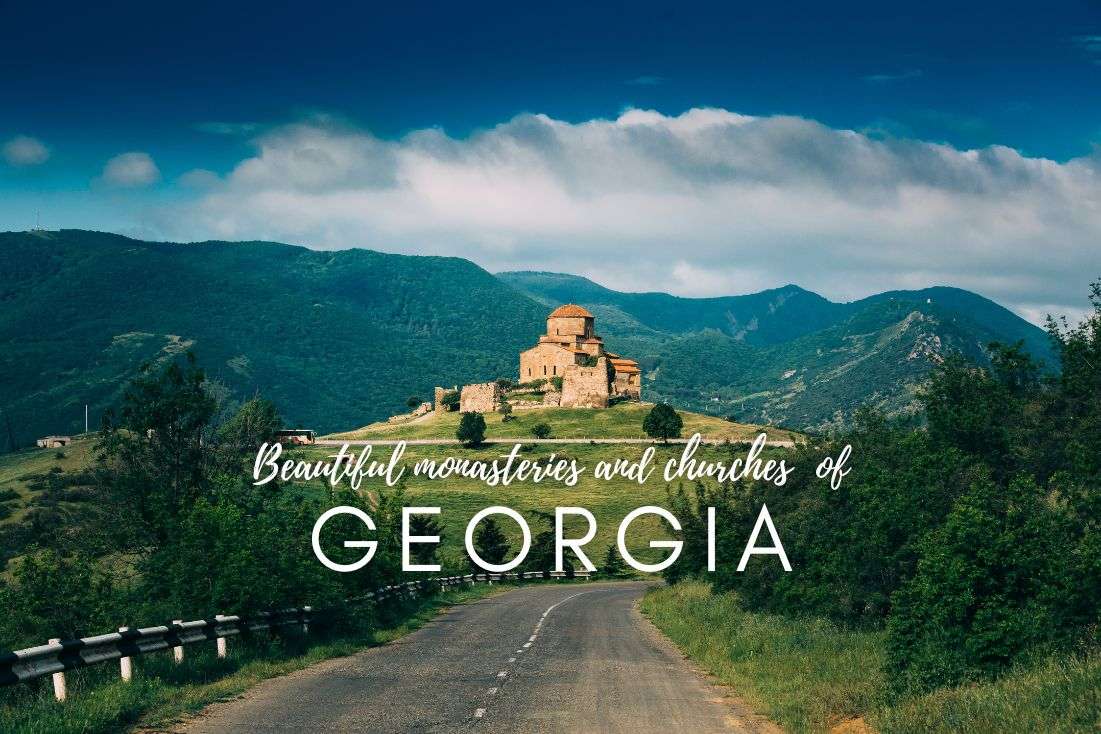
2. Gelati Monastery - UNESCO World Heritage Site
3. Vardzia cave monastery - also a UNESCO World Heritage Site
5. Holy Trinity Cathedral of Tbilisi (Sameba)
7. David Gareja Monastery + Natlismtsemeli Monastery
What is the most famous monastery in Georgia?
There are two things that Georgia does well: mountains and religious sites (and not much else, to be frank). A lot of times, you get a church in the mountains or a monastery on a hill, so basically a combination of the best that Georgia has to offer. It kind of reminded me of Israel in the number of religious sites. But there are also cave monasteries, churches on high pillars, and places that straddle the borders to neighboring countries... the options are almost endless!
If you’re putting together an itinerary for your Georgia trip, you’ll probably end up switching between hikes, glacier viewpoints, monasteries, and churches, with some Soviet architecture thrown in for good measure. Unless you’re also hoping for a good beach holiday, in which case, good luck.
So, let’s take a look at some of the best monasteries, churches, and holy spots that you could put on your Georgia bucket list. I’ve sorted through the country’s most famous and lesser-known spots to give you the ultimate list of the top ones you need to visit. I’ll tell you what to visit, why, and how.
Here is the list of the most Beautiful Georgian Monasteries:
- Gergeti Trinity Church
- Gelati Monastery
- Vardzia Cave Monastery
- Bodbe Monastery
- Holy Trinity Cathedral in Tbilisi (Sameba)
- Anchiskhati Basilica
- David Gareja Monastery
- Mtskheta Holy City
- Bagrati Cathedral
- Nekresi Monastery
- Kaskhi Column
In addition here’s a map of the best churches in Georgia to head to, followed by a detailed description of each epic spot:
I’ve made a list of the places in this article on Google Maps. Feel free to save it!
You might also be interested in reading:
- A Practical Georgia Itinerary for 7–10 Days
- Top Boutique Hotels in Georgia
- 7 Epic Day Hikes in Georgia
- Top 20 Amazing Places to Visit in Georgia
1. Gergeti Trinity Church

Gergeti Trinity Church is Georgia’s Eiffel Tower
Gergeti Trinity Church is the church that you’ve seen on all the photos of Georgia—it’s like the country’s poster child. I don’t think anybody’s going to question that the reason this church is so sought after is its spectacular location. It stands right outside of the town of Stepantsminda in northern part of the country, right under Mt. Kazbeg and the amazing ridges of the Caucasus.
The interior of the church is just like any other church in Georgia, it smells like insense, it has frescoes, all that jazz, but it’s those views that steal the show. The mountain views are just phenomenal.
Now, let's talk about my personal infatuation with this place. Mount Kazbek, with its glorious glacier-capped peak, was my first encounter with a majestic 5,000-meter (16k ft) mountain. And let me tell you, it's etched in my memory as one of the most awe-inspiring sights to this day.
Apart from ogling the church and views, another reason lots of people gather around here is that Gergeti Trinity Church is where the hikes to Mt. Kazbeg start.
Getting to Gergeti Trinity Church
No worries though, you don’t have to exude too much energy to get to Gergeti Trinity Church. There’s a road that leads right up to the little hill that the church is perched up on, and you can park right there (and in other places along that road), too. The drive from Stepantsminda only takes 15 minutes. It’s free, as is the church entry.
Gergeti Trinity Church on Google Maps
2. Gelati Monastery - UNESCO World Heritage Site
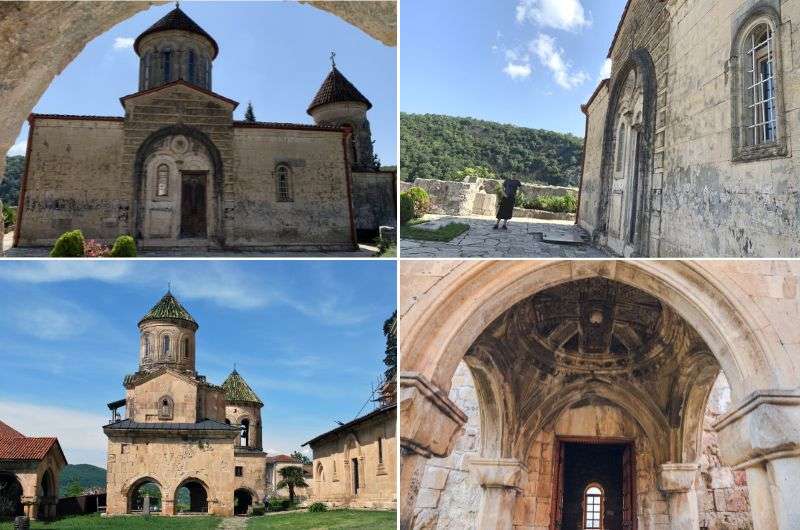
Gelati Monastery is Georgia’s UNESCO World Heritage Site
Unlike Kutaisi’s other famous landmark, Bagrati Cathedral, Gelati Monastery holds onto its UNESCO status like a boss. The monastery is outside of the city, but it counts as the most important place to visit in Kutaisi in my book, like a substitute for Bagrati.
With epic views into the distance and similarly epic interiors, Gelati is one of the highlights of my visit to Georgia. It was one of Georgia’s first monasteries, founded at the very beginning of the 12th century. If you feel like you can see Gelati from miles away, you’ll make the founders very happy, because the goal was for the complex to be visible from the entire country.
The grounds include several buildings, and they are fun to explore and wander around. One of them serves as an exhibition hall, so make sure to peek in to see what’s going on there. But most of all, it’s like you can feel history emanating from the stones of these buildings. Inside, you’ll find awe-inspiring works of art on the walls, including triptychs and mosaics, as well as some pretty cool and very, very old doors. You’ll also probably find scaffolding due to ongoing work.
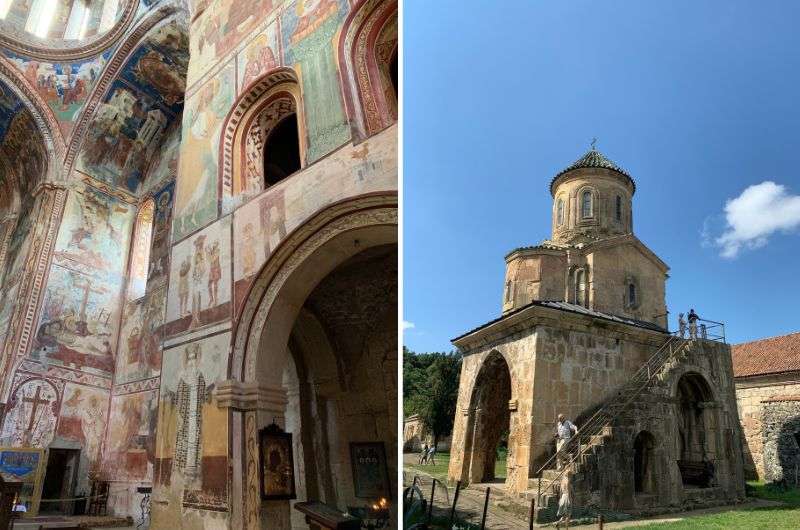
I really enjoyed soaking up the atmosphere of the Gelati Monastery complex
Top Tip: If you can’t get enough of Gelati's goodness, take a walk on the trail that leads from the monastery through the surrounding forest. It takes you past some more religious buildings that are scattered amongst the trees.
Getting to Gelati Monastery
Gelati Monastery complex is located 9 km (5.5 mi) northeast of Kutaisi’s city center, so about a 15-minute drive. As is standard in the country, there are no entrance fees. Put aside at least 1.5 hours to give Gelati Monastery the time it deserves.
There’s no entrance fee. Parking is easy on-site near the entrance of the monastery.
Gelati Monastery on Google Maps.
3. Vardzia cave monastery - also a UNESCO World Heritage Site
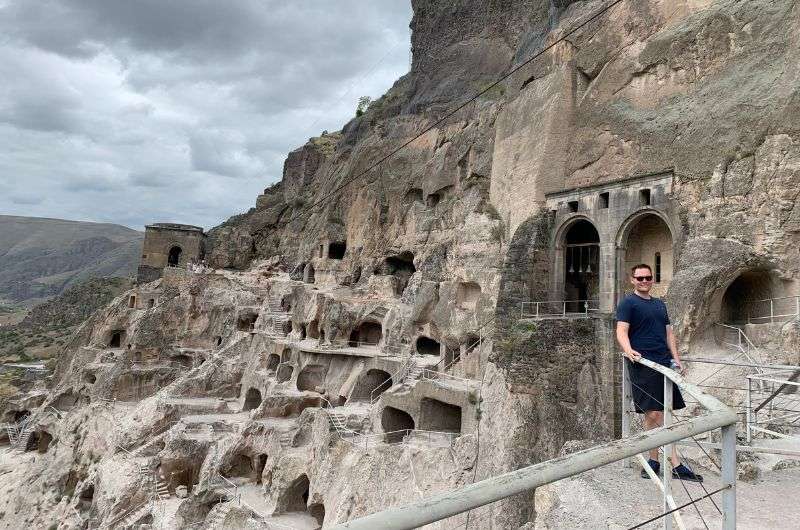
Chilling around the Vardzia cave complex
Now, it’s time for something a little different... Vardzia monastery isn’t just any ol’ monastery, it’s a monastery carved into a mountain! The captivating Vardzia cave complex feels like an ancient city, a UNESCO World Heritage Site, and will leave you in awe. Case in point—we spent half a day wandering around the former city, and I barely ever make that much time even for real cities!
With origins dating back to the 12th century, Vardzia boasts over 700 rooms on several floors and, of course, the star attraction—the monastery. Though ravaged by earthquakes over the years, you can still very much imagine the bygone era when this complex could accommodate over 50,000 people.
You can walk through paths and tunnels, climb up stairs and ladders, and, since you’re here to read about Georgia monasteries, make sure to marvel at the mesmerizing pillars and intricate frescoes adorning the monastery walls. To be quite honest, the monastery interior looks a lot like a regular Georgian Orthodox church, which might surprise you since, you know, you’re in a cave. But then you realize—“I’m inside of a mountain!” And it’s just so cool.
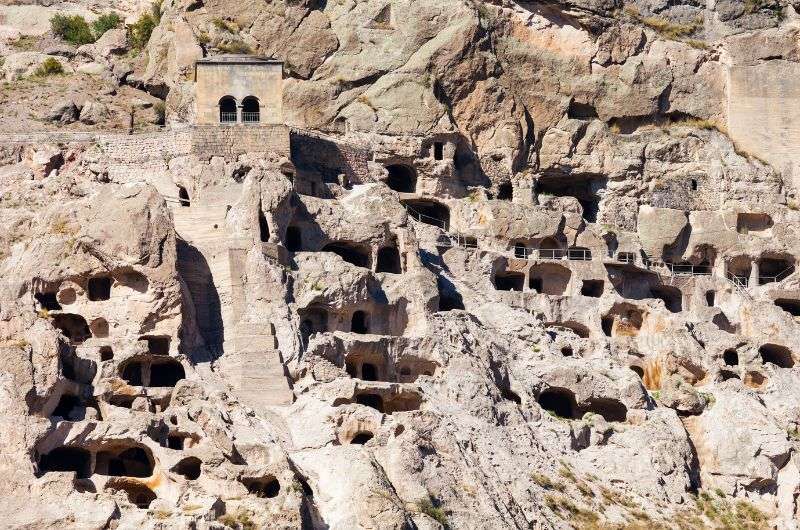
It was really fun to explore this place!
Getting to Vardzia monastery
Now, let's talk about the road to Vardzia. Brace yourself for a scenic drive through the picturesque Georgian countryside, but be warned—road rage is a real phenomenon here. So, put your pedal to the metal and hope for a safe passage through the wild Georgian traffic!
Tickets cost GEL 15 (USD 6), and if you crave a more in-depth learning experience, audio guides are available for an additional GEL 15.
Vardzia cave complex on Google Maps
4. Bodbe Monastery
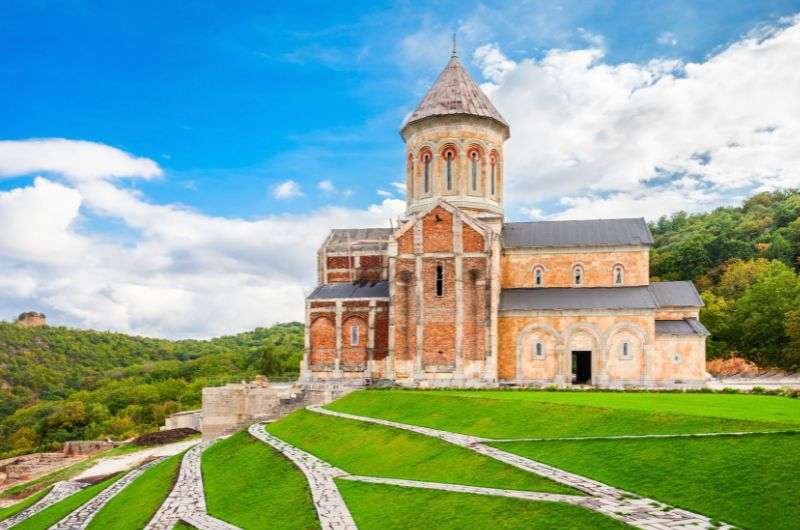
Bodbe Monastery—A place dedicated to Saint Nino
Bodbe Monastery is right outside of Sighnaghi in Georgia’s Kakheti wine region. It was built in the 9th century in the spot where St. Nino took her final bow. This legendary lady is the one we have to thank for all these incredible monasteries and churches scattered across the country. She brought Christianity to Georgia, and now we get to take vacations here and marvel at these amazing places of worship. Thanks, St. Nino!
The church and nunnery are, understandably, a major pilgrimage site in Georgia. There are several religious buildings on site—look for St. Nino’s tomb in the smaller church. I thought the detailed carvings on the church doors were fantastic, and enjoyed the spacious green lawns with gardens full of flowers. Actually, I was impressed with how well the buildings and grounds were upkeep. Not something you see every day in Georgia, trust me.
As a bonus, St. Nino’s convent in Bodbe is built on a hill, which means gorgeous views of the wine region.
So, when you find yourself standing in awe of the stunning Bodbe Monastery, raise a toast to good ol' St. Nino for making it all possible.
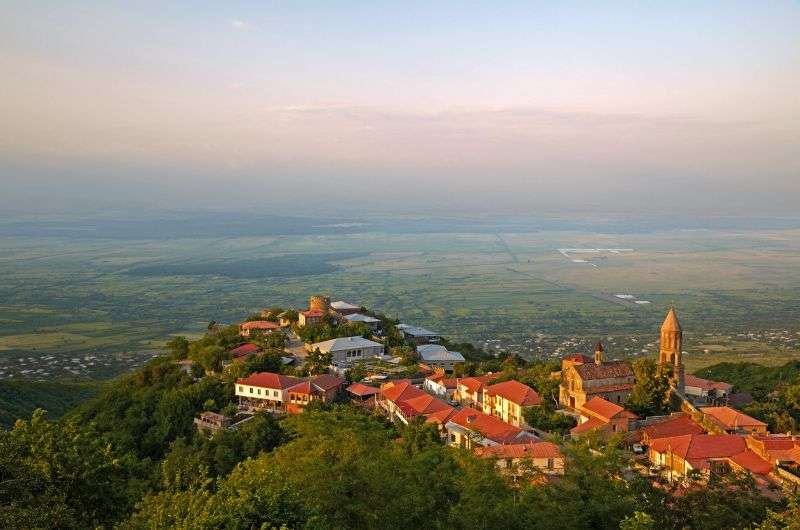
View of Kakheti wine region
Tip: If you’re a big fan of St. Nino, you can also take a roughly 25-minute hike to St. Nino’s spring on the hill across from the monastery. St. Nino prayed it into existence, and now there’s a church and another building there. The trail to the spring starts with stone stairs from Bodbe Monastery, but be ready for dirt and possibly mud in the forest if it has rained recently. You can drink the water, it’s apparently somehow magical or miraculous or something of that sort.
Getting to Bodbe Monastery
If you’re coming from Tbilisi, Sighnaghi is about a 1.5-hour drive. Bodbe Monastery is just a further 2 km (1.5 mi) outside of town, accessible by a steep road. There’s a parking lot right by the entrance that should probably be free, but there is always a dude there making up random prices that naive tourists are happy to pay. Entrance into the monastery is free. The only thing that’s paid for are the toilets.
I recommend coming here as part of the Kakheti day trip, which I describe in my One Day Trips from Tbilisi article. It’s got pretty views of the winemaking scenery, pastel houses, and wine. Perfect, no?
Bodbe Monastery on Google Maps.
5. Holy Trinity Cathedral of Tbilisi (Sameba)
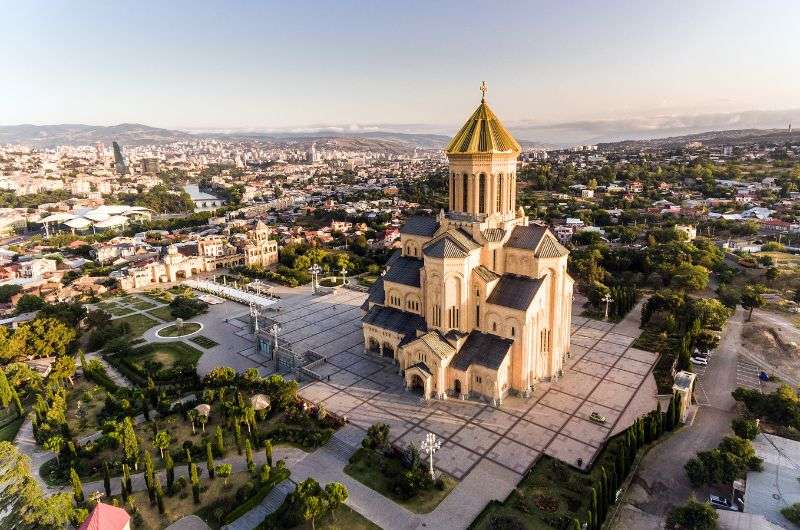
Sameba aka Holy Trinity Cathedral
Sameba is Tbilisi’s main church and one of the largest religious buildings in the world, and the biggest in Georgia. When you lay your eyes on it, you'll think it's a churchception–a church on a church on a church on a church! This behemoth can fit 10,000 people inside.
Thanks to the shimmering, golden rooftop, you can spot this bad boy from miles away. I can’t imagine what the Tbilisi skyline did without it, because now, you can’t not see it from anywhere in the city.
If you happen to visit at sunset, when the orange light hits the facade, it’s just short of setting the city on fire. Seriously, this church shines like a beacon, guiding lost souls and awestruck tourists alike. Some would even call it magical.
Tip: I have to mention Hotel 21 in Tbilisi, because if you want to be close to this megalodon of a church, it’s the place to stay. It’s brand spanking new and has heavenly beds and a cool design. Get yourself booked into a room on the higher floors for incredible views of Sameba’s towers (or of the mountains, which aren’t half bad either).
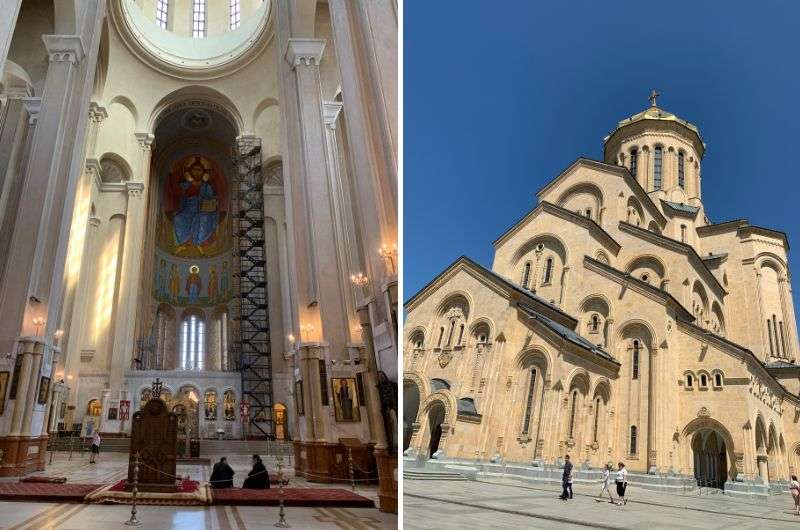
Majestic inside out
The inside of the church is like stepping into a Renaissance painting, minus the stuffy museum vibes. Think intricate frescoes, golden icons, and ornate details that will make your eyes pop. But it’s not like most Orthodox churches in Georgia, which are often dark and mysterious, with walls covered floor to ceiling with frescoes. Sameba’s construction was finalized in 2004, so it’s pretty new for a church, and it’s very white, light, and bright inside compared to some of the older specimens you will visit on your trip.
Getting to Sameba
The complex has several entrance points, but the main entrance is where Erevan Street turns into Samreklo Street. This is the way you should enter to get the full grand entrance to the cathedral—complete with a wide staircase lined with statues. But don’t be feeling like Ilia II just yet, you can’t use the main entrance of the actual church to get in. The public door is to the right of the fancy, tall doors that are not meant for us regular folk.
Holy Trinity Cathedral of Tbilisi's opening hours are from 8 am and 10 pm. Liturgy is on Saturdays around 4 pm and Sundays at 10 am. Free entry.
6. Anchiskhati Basilica
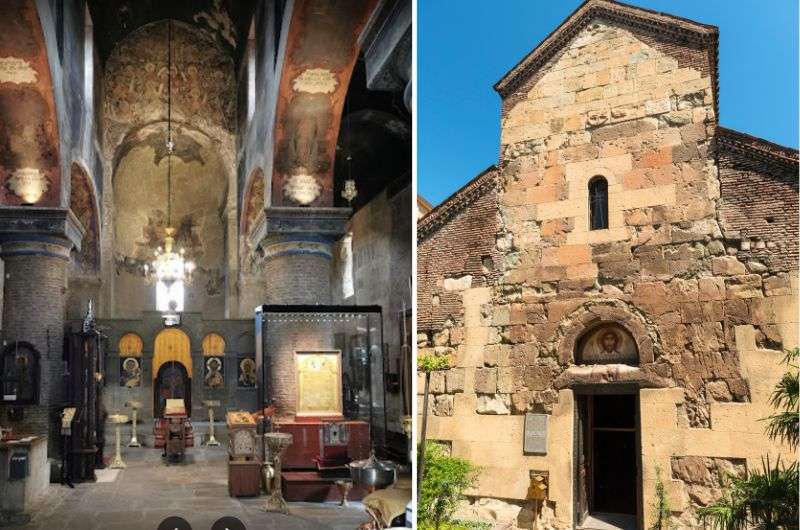
Anchiskhati Basilica, the oldest church in Tbilisi
Anchiskhati Basilica is the ancient survivor of Tbilisi's ups and downs, and the capital’s oldest church. This church, built in the 6th century, has seen it all, from wars and damage to questionable architectural decisions. I mean, adding a dome in 1870? Did they think it needed a fashion upgrade?
This is the type of old church where you can really tell it’s old. The exposed bricks on the columns and hard-to-make-out frescos, probably as gloomy back then as they are now, add an extra touch of intrigue.
But Anchiskhati Basilica is not just any old church; it's the headquarters of the Anchiskhati Choir. Every Sunday at 10 am, prepare to be chilled to the bone by the captivating harmonies echoing through the church.
The church changed its name to Anchiskhati Basilica in 1675 when the Icon of Ancha was brought there from today’s Turkey to protect it from the Ottomans. If you are interested in seeing the magical imprint of Jesus’ face that named the church, it’s waiting for you in the National Art Museum of Georgia.
During the Soviet era, as was standard practice in all religious sites, Jesus was evicted and religious events were banned. They finally got rid of that extra dome in the 50s/60s, and in 1991, Jesus returned home, ready to rock the house again.
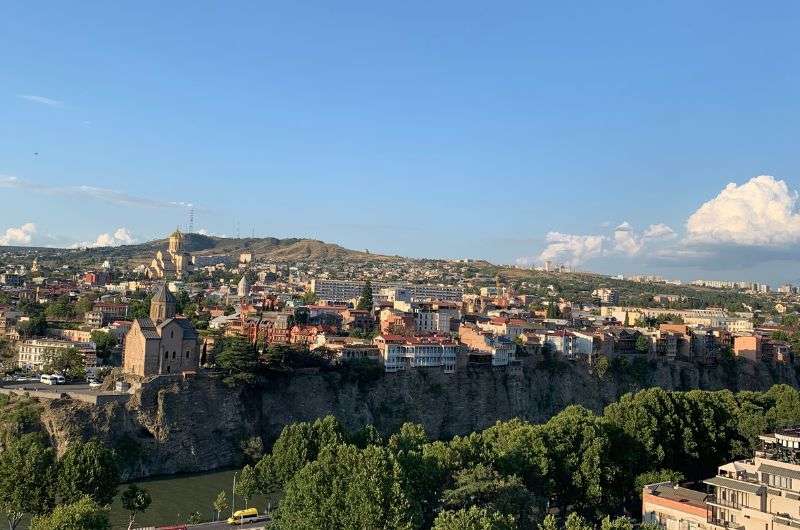
Tbilisi
Tip: Anchiskhati Basilica is in the heart of Tbilisi’s Old Town, and there’s not much more typically old and Georgian than historical houses with colorful wooden balconies. In case you’re in the planning stages of your Georgia trip, I want to recommend this fantastic hotel that’s just a couple of blocks from Anchiskhati Basilica: Blue Balcony Hotel. Full disclosure, I get a small commission if you book it through my link, but it costs you nothing extra, and I really think it’s one of the best hotels in the country.
Getting to Anchiskhati Basilica
Anchiskhati Basilica is located in Tbilisi’s Old Town right next to Gabriadze Theater (the one with the crooked tower). As far as I could tell, it’s always open, but I was there in the regular daytime hours, not at 2 am, so I can’t be held accountable if you need a little church time in the middle of the night and they don’t allow it.
Liturgy, complete with Georgian polyphonic singing, is on Sundays at 10 am.
Anchiskhati Basilica on Google Maps.
7. David Gareja Monastery + Natlismtsemeli Monastery
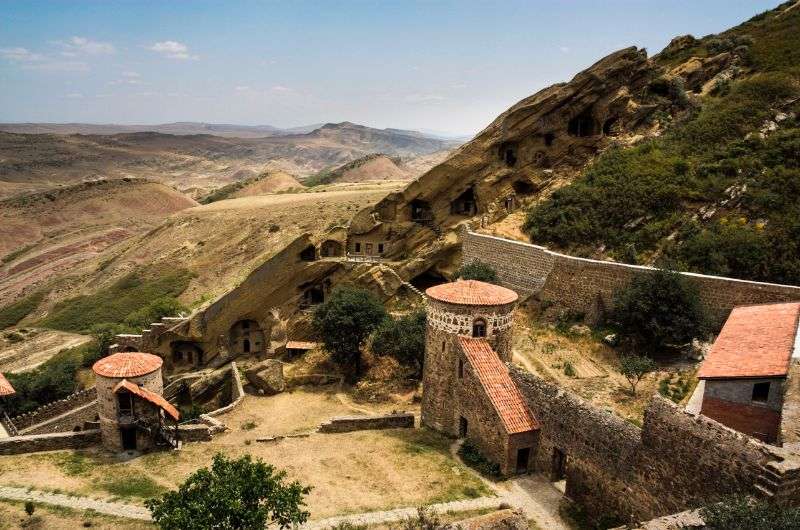
David Gareja Monastery is still inhabited by monks
Once upon a time, you could play spy and catch a glimpse of Azerbaijan from the upper part of the David Gareja cave monastery complex. But, due to some not-so-friendly neighborly relations, that opportunity is currently off-limits. Oh well, you’ll still get plenty of nice views of the colorful hills of Georgia.
You read correctly, another cave monastery! But this one is prettier in the traditional sense since it’s still inhabited and being maintained by a couple of monks.
Even though you can’t wander around the entire complex freely, and certainly not the upper part that could cause you to fall into Azerbaijan, the lower Lavra Monastery is still open for exploration. It's like stepping into a religious wonderland carved into the rock, complete with prayer rooms and living quarters (that you can’t visit). The monks have even added some flowers to give it that homey cave-house vibe.
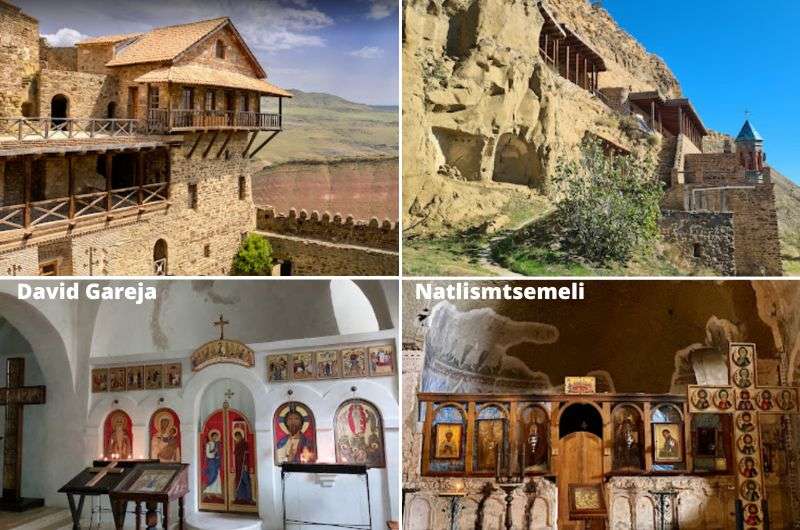
David Gareja is the more polished of the two
Now, here's a secret tip for the true explorers out there. Just a short 10 km (6 mi) drive from David Gareja, you'll find the hidden gem known as Natlismtsemeli Monastery. You'll need a sturdy 4x4 vehicle to conquer the rough road (unless you’re a local, in which case, you can probably make it there in your grandma's beaten-up sedan). There's only one monk living there, so you'll have your own personal tour guide. Beware he’s grumpy sometimes.
Getting to David Gareja and Natlismtsemeli Monasteries
David Gareja monastery complex is 98 km (60 mi) from Tbilisi city center, and the drive will take you about 2 hours, but you’ll feel like you just drove to the end of the world. The road has now been paved all the way to David Gareja. Natlismtsemeli has received no such modern-day convenience, and you’ll need to be ready to offroad for a few minutes to get there.
Parking is easy since there’s literally nothing around but open plains. You won’t be charged for parking or entry.
Natlismtsemeli Monastery on Google Maps.
8. Mtskheta Holy City
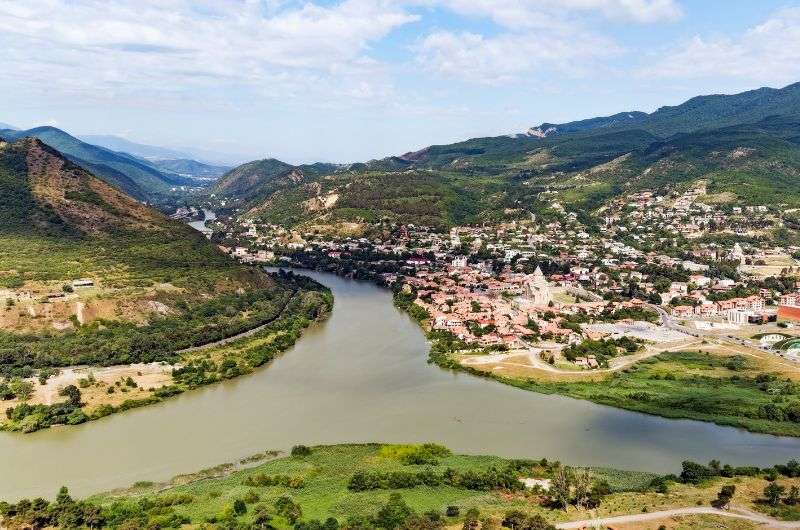
Mtskheta—the city of churches and holy places
I’ll pile all of the religious sites in Mtskheta into one item on this list because there are quite a few to see. Additionally, Mtskheta was declared a Holy City by the Georgian Orthodox Church, so if you’re serious about seeing some churches and monasteries in Georgia, you’ll be like a kid in a candy store.
Svetitskhoveli Cathedral is right in the middle of town and it’s the second-largest church in Georgia, right after Sameba in Tbilisi. Inside, many of the original frescoes were lost to some Soviet stupidity, but there are a few leftovers for you to look at. Otherwise, it’s more stone walls and paintings. But it’s not just its size and Russian destruction that lure in the pilgrims and tourists, it’s the fact that a piece of Jesus’ robe is buried there. Cool? Weird? Improbable? Take your pick.
The most popular among tourists in the holy sites in Mtskheta is Jvari Monastery. It stands on a hilltop to the east of town, which means views of Mtskheta, the confluence of the Mtkvari and Aragvi rivers, and the mountains. The location was chosen by St. Nino herself. She had a big wooden cross erected here, and then some other people built all the other stuff.
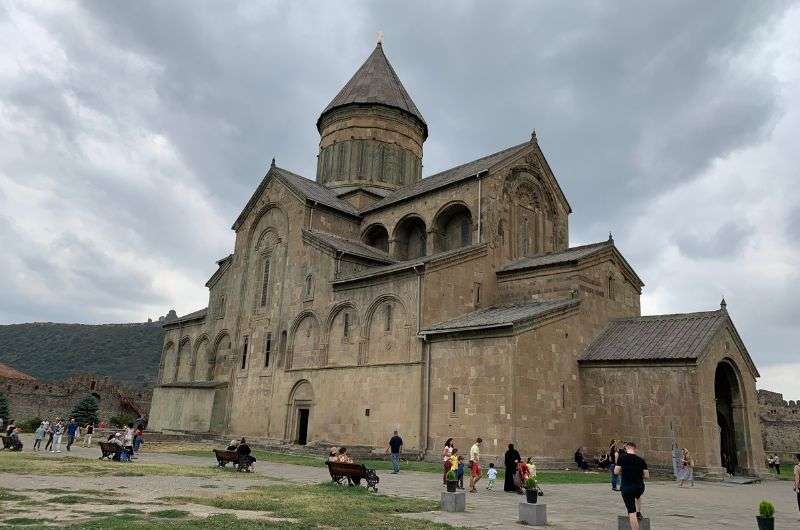
The Svetitskhoveli Cathedral
Hungry for more? You can very easily continue on a tour-de-monasteries around Mtskheta, visiting places like Samtavro Monastery, Shiomgvime Monastery, and Zedazeni Monastery, to name a few.
Getting to Mtskheta
Mtskheta is 23 km (17 mi) north of the center of Tbilisi, so the drive will take you about 30 minutes. It’s a very popular day trip from Tbilisi.
There’s a parking lot very close to Svetitskhoveli Cathedral.
To visit Jvari Monastery, you’ll want to park your car in the parking lot there. It’s supposed to be free, but it depends if you are able to say no to the men who pretend to work there and demand payment.
Jvari Monastery on Google Maps
9. Bagrati Cathedral
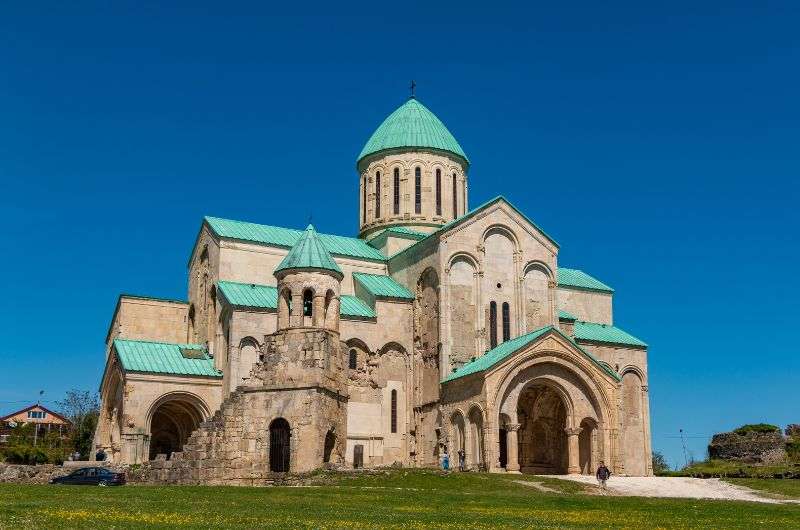
Bagrati Cathedral—the ex-UNESCO monument
Bagrati Cathedral, located on a hill in Kutaisi, is an 11th-century cathedral with a really strange renovation past. Basically, it’s really old and totally destroyed.
Work on what was apparently a masterpiece of medieval Georgian architecture started in the 1950s, and after 40 years, UNESCO applauded the finished product and added it to its Heritage List. Fantastic work, guys, the cathedral looks great! But then the “guys” got a little cocky, kept going with the restoration process, but ended up on UNESCO’s naughty list in 2010. While the main architect of the recent reconstruction got the Georgian gold medal for his work, UNESCO finally removed Bagrati from its World Heritage List altogether because of how destroyed the historic value of the cathedral was. A shining example of Georgia’s mentality: inconsiderate and disrespectful.
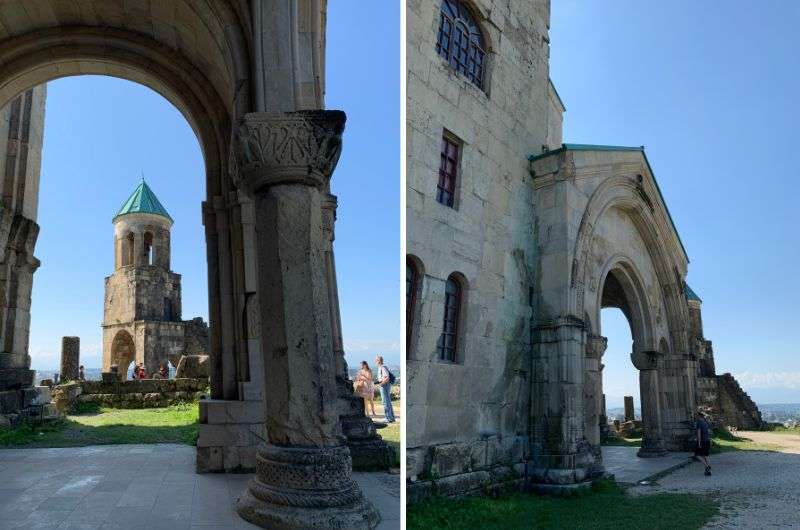
If you’re touring Georgia, you’ll probably use Kutaisi as a base for the western side of the country, so go ahead and visit Bagrati and take a look at the botched work, you know you want to do. One thing that they didn’t destroy is the fabulous views—you can see all of Kutaisi backed by snow-capped mountains from the church grounds. There are also palace ruins on the site that the local children like to use as a playground.
Getting to Bagrati Cathedral
Bagrati Cathedral is about a 1.5 km (1 mi) walk from downtown, up towards the north where the Botanical garden is. You’ll be up on the hill in about 20 minutes if you start at the Colchis Fountain.
If you decide to drive, there’s a parking lot right next to the cathedral as well. There is no entrance fee.
Bagrati Cathedral on Google Maps.
10. Nekresi Monastery
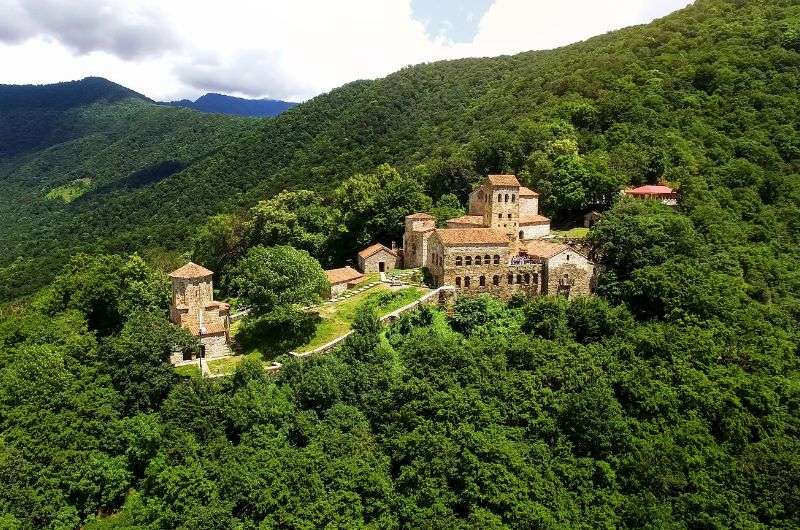
Nekresi Monastery, hidden in the woods
We felt we found the best views in the Kakheti wine region (in the easternmost part of Georgia) when we visited Nekresi Monastery. I’m not exaggerating, they are postcard-perfect, especially if you make your way here during sunset.
Nekresi isn’t as well-known as some of the other churches and monasteries in Georgie that are on this list, which could make it that much more intriguing. It’s perfectly perched on the hillside above the vineyards of Kakheti. It’s a well-maintained complex where you’ll want to spend an hour wandering around the stone buildings, taking in the panoramic views below.
Now, here's something that caught me by surprise. Those monks at Nekresi sure know their way around winemaking! They not only spend their days in prayer and reflection but also produce their own wine. Make sure to swing by their little shop and taste their divine creation. Fair warning, though—it's on the sweeter side. Oh, and don't forget to admire the wine cellars.
Also within the walls of Nekresi Monastery lie some of Georgia's saints—literally. You'll have the unique opportunity to see the actual bones of these revered figures.
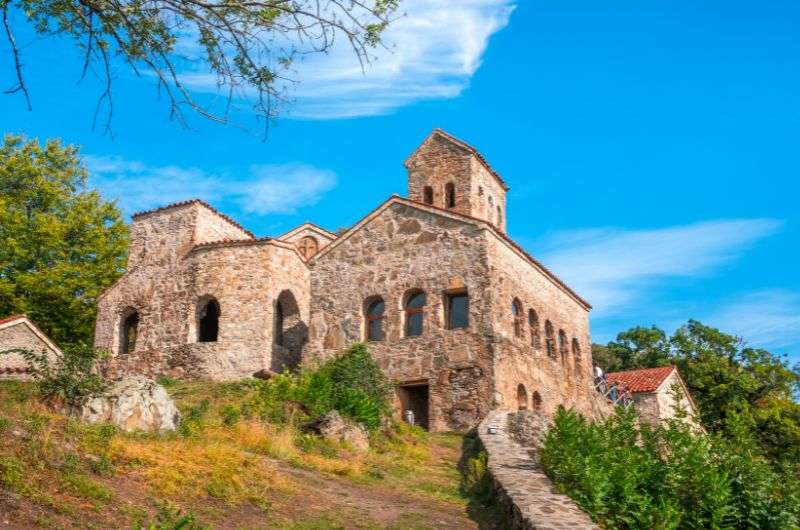
Walking tour to Nekresi Monastery
Tip: If you prefer to drink your wine in a higher style, stop by one of the best wine estates in the Kakheti region, like Vazisubani Estate and Tsinandali Estate. They both double as 5-star hotels, so you can do all your wine tasting with a side of free-standing bathtubs, infinity pools, and cute picnics on the manicured estate grounds.
Getting to Nekresi Monastery
You either need to walk up the hill for an hour or take the monastery-issued shuttle to get to Nekresi. No self-driving is allowed, but people do it—it’s up to you if you want to go against the orders. It seems that on days with few tourists it’s easier to do. The shuttle bus costs GEL 1.5 each way. I recommend just walking, because when you get on the minibus, not only do you have to brace yourself for a typical local driving experience (read: not for the faint of heart), but you also have to sit there and wait for the minibus to fill up before you leave.
Nekresi Monastery on Google Maps.
11. Katskhi Column
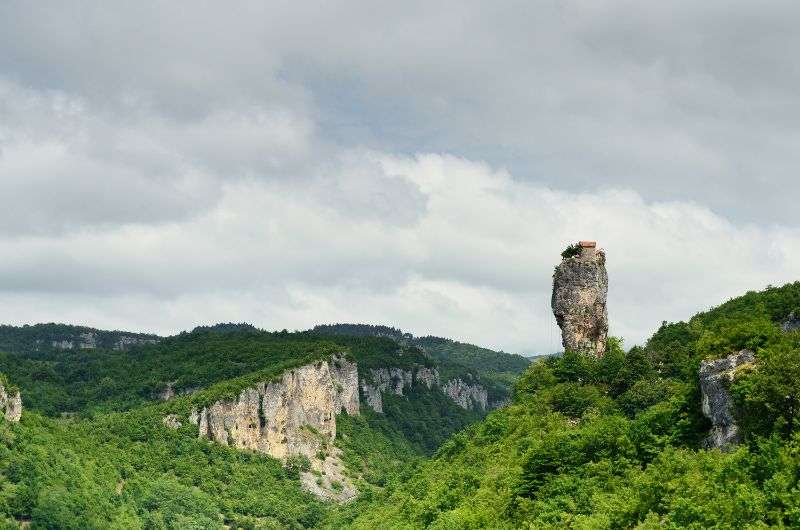
This church on a rock column was once inhabited by a monk. A perfect place for solo contemplation.
Katskhi Column is a tiny church complex on a big pillar near Chiatura, both of which are often visited as a day trip from Kutaisi. Yeah, you heard me right, a church perched atop a 40 m (130 ft) limestone column.
You can’t actually visit the top of the column, so don't get your expectations soaring too high (pun intended), but it is one of the neatest little churches in Georgia thanks to its odd location. I find it fascinating that it’s not just one building up there, there are two! I think... can’t tell for sure, I’m not the lone monk that used to live there (until he died there). But there are supposed to be a crypt, a wine cellar, and 3 hermit living quarters, so you’d think he’d invite somebody over for a sleepover from time to time instead of hogging all the wine for himself.
I'll be honest with you, the Katskhi Column isn't going to blow your mind with its size or grandeur. But there's something strangely captivating about its simplicity and the sheer audacity of building a church like this. Visit Katskhi Column sheerly for the unusual architectural choice.
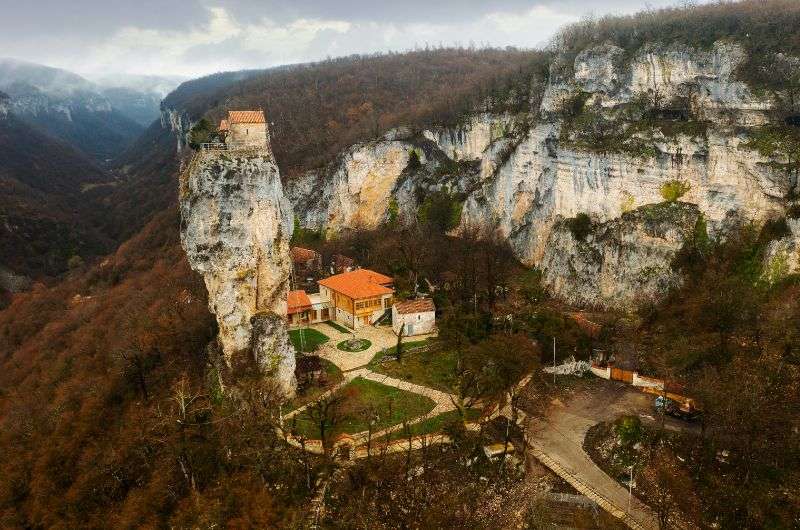
From this perspective, it can be seen that the Katskhi Column is not that inaccessible.
Men (and men only) used to be able to climb up the ladder to the church, but that is no longer possible. There used to be a monk that lived there for 20 years (until he died there) and now only the monks from the church at the base of the column come up to the church from time to time to hang out with God. They’d like to be the sole humans on the pillar, thankyouverymuch. The public is not invited over for tea (or wine).
There is a newer church at the base of Katskhi Column that you are welcome to peek inside.
Getting to Katskhi Column
Katskhi Column is a little over an hour away from Kutaisi driving on pretty good, though sometimes narrow, roads. You’ll see signposts directing you to Katskhi Column parking. Park at the first parking area and walk the rest of the way unless you enjoy driving on bumpy dirt roads.
Don’t try to take public transportation to the Katskhi Column. It will take absolute ages (3 hours!), which, considering you only need to spend maybe 20 minutes at the column, is definitely not worth the journey.
Katskhi Column on Google Maps.
No to the point of the most important question before you visit Georgian Monasteries - How to behave?
Church etiquette in Georgia
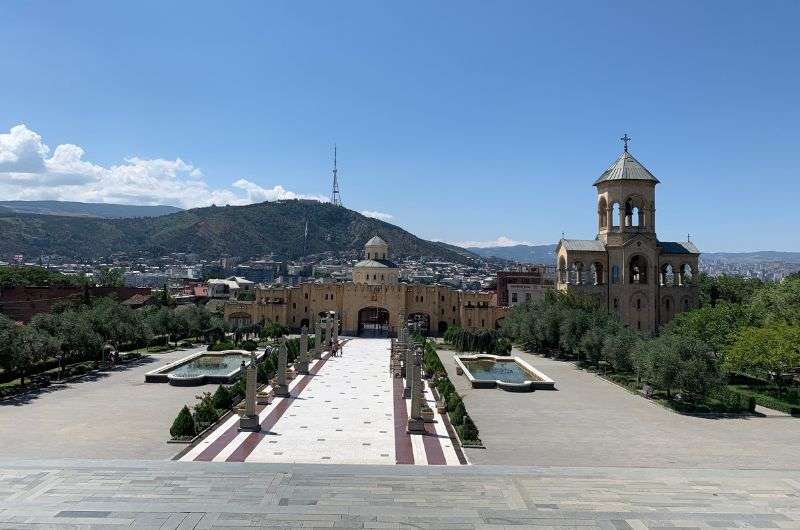
Visit the majestic Holy Trinity Cathedral, it’s definitely worth it. Just be respectful!
It’s no surprise that visiting a church or monastery anywhere in the world has its own set of rules and expectations about behavior. In Georgia, there’s nothing that’ll surprise you too much, it’s just common sense for the most part.
Here’s how to behave in a church in Georgia so you have the best experience:
- Dress code. Dress modestly, and have your shoulders and knees covered. If you’re a woman, cover your hair with a headscarf. Most churches that are frequented by tourists have a basket at the door where you can borrow a wrap to cover your legs and a scarf for your hair (you might want to carry your own for hygiene reasons). If you’re in faraway churches, pants for ladies will be looked down upon, and you’ll still need to wear the wrap. Apparently, Jesus doesn’t appreciate it when you show you have two separate legs.
- There are no entrance fees at Georgian churches, with the exception of the Vardzia cave complex. That’s not to say there won’t be people at the door asking for money. Usually, there isn’t a parking fee either, so if there’s a man asking for money at the parking lot, be wary.
- Inside a church or on the grounds of a monastery in Georgia, keep quiet. I think you’ll do this automatically when you see how gloomy and solemn some of the churches feel.
- Many churches prohibit taking photos inside.
Now that you’ve quieted down and covered those muscular arms of yours, I can finish this article with some answers I would love to know before visiting the monasteries.
FAQs
What is the most famous monastery in Georgia?
Arguably, it is the Gelati Monastery, built in 1106, which is considered the most famous due to its status as one of the best to visit. The views are excellent, and the site is quite large, taking at least two hours to explore. The buildings are simply beautiful.
Which is the oldest monastery in the Georgia?
The oldest monastery in Georgia is Martvili Monastery, which was rebuilt as a monastery in the 6th century. Most monasteries in Georgia are ancient, as the country was one of the first to adopt Christianity in the 4th century.
Do I need to pay while visiting monasteries in Georgia?
Most of the monasteries are free to visit. However, some monasteries might have a small charge due to being overrun by tourists and being quite expensive to maintain, but the charge usually does not exceed 3 USD.
This post contains affiliate links. I earn a small commission if you make bookings through my links, at no additional cost to you. This helps keep this blog free, thank you!
2. Gelati Monastery - UNESCO World Heritage Site
3. Vardzia cave monastery - also a UNESCO World Heritage Site
5. Holy Trinity Cathedral of Tbilisi (Sameba)
7. David Gareja Monastery + Natlismtsemeli Monastery
What is the most famous monastery in Georgia?


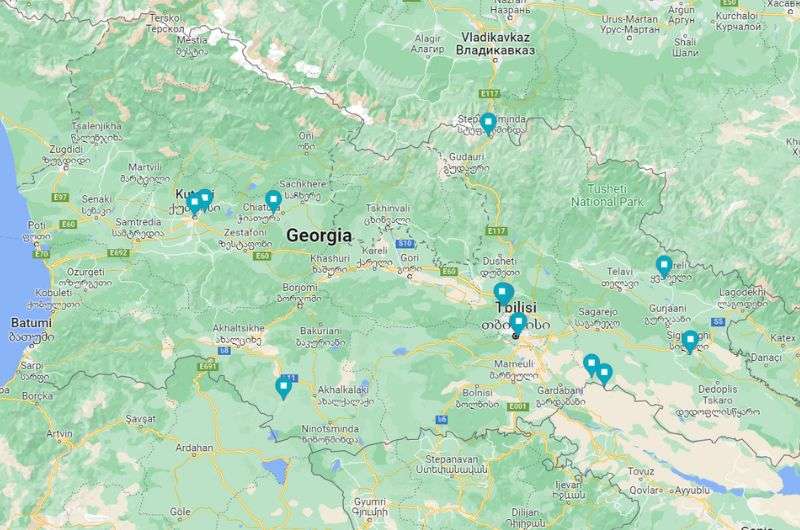
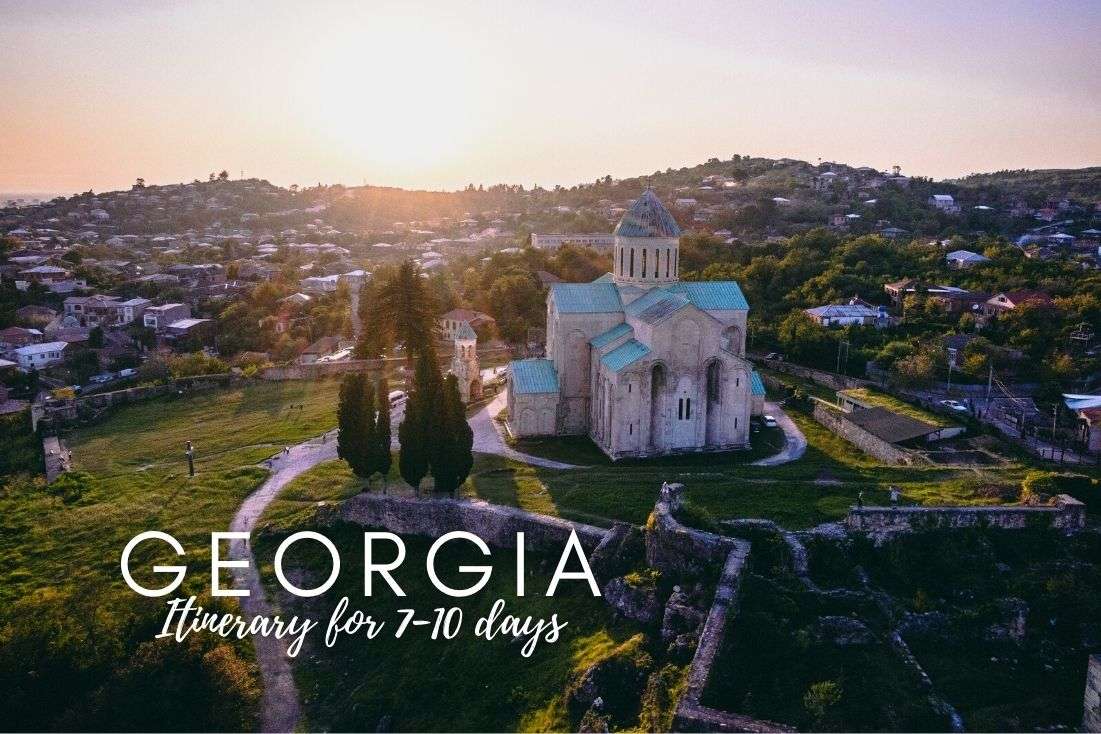
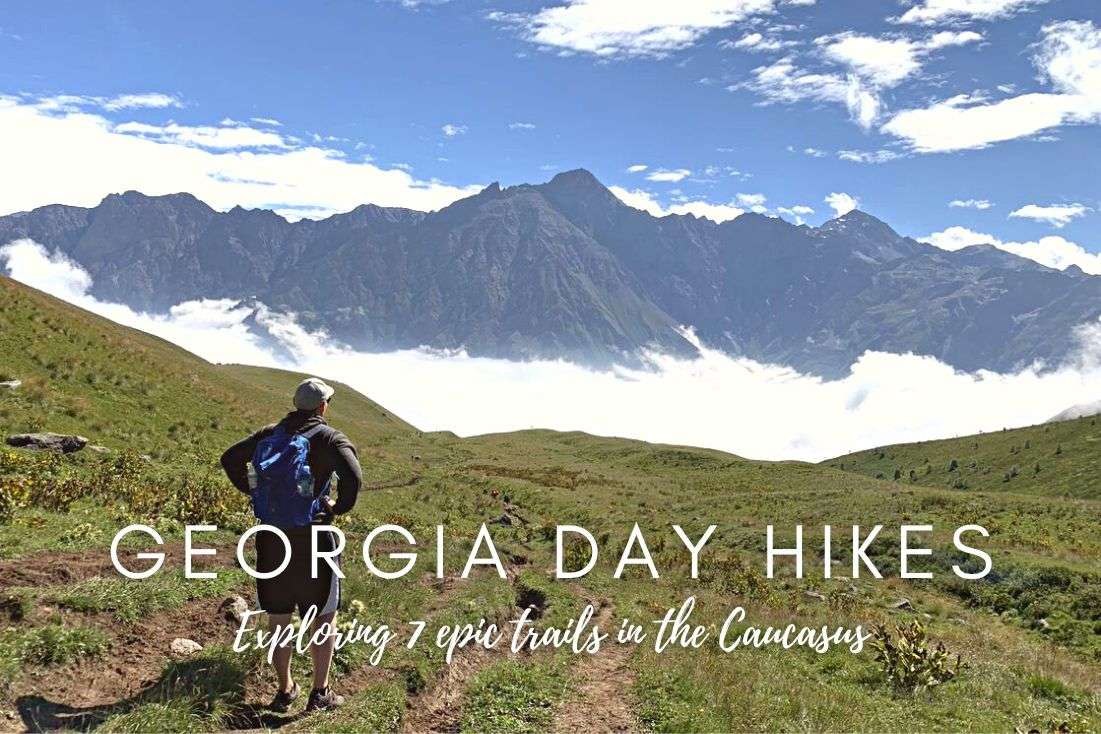
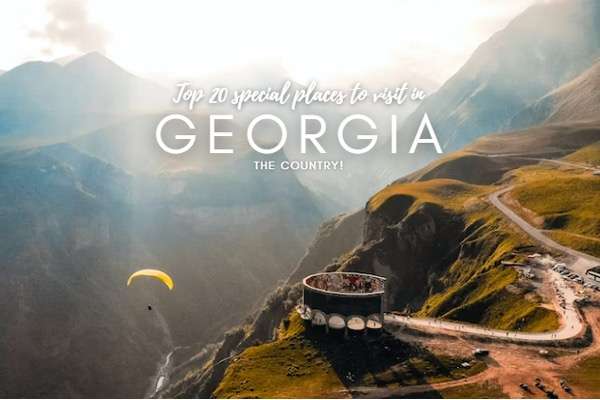





Comments | Thoughts? Give us a shout!